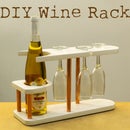Introduction: Turning an Old and Rusty Wheelbarrow Into a Flower Planter
In this Instructable I’m going to show you how I turned an old, rusty wheelbarrow into a wonderful garden planter. It required a lot of work, but the end result was definitely worth every second I’ve put into this project.
This was my first restoration project, so you can check out the video as well, and tell me what you think in the comments section bellow.
Materials:
- Rust Remover https://amzn.to/2PzKPNy
- Primer for Metal https://amzn.to/2GEyzXJ
- WD40 https://amzn.to/2Dxkn2k
- Spray Paint https://amzn.to/2DvkcnR
Tools:
- Angle Grinder https://amzn.to/2GyIqhT
- Wire Brush https://amzn.to/2GyyLYP
- Wire Brush Wheel https://amzn.to/2XJrQCW
- Flap Disc https://amzn.to/2J2s6Jj
- Dremel multi-tool https://amzn.to/2DznfLM
- Painting Kit https://amzn.to/2Zx7PkF
Now, let’s get started!
Step 1: Cleaning the Wheelbarrow and Scrubbing the Heavy Rust
I cleaned all the dirt from the surface with a small broom. Then, I took a wire brush and removed the heavy rust. After scrubbing all the rusted areas for a while, I couldn’t feel my arm anymore, so I threw away the wire brush and decided to continue with a power tool.
Step 2: Moving on With an Angle Grinder With a Wire Wheel Attached to It
I took an angle grinder and installed a wire wheel onto it, which actually has the same function as the wire brush that I used, but it is so much faster. I haven’t used angle grinder before, but I got used to it easily.
Disassembling the wheelbarrow was not an option, so some parts were hard to reach. That’s why I switched to a drill with 60 grit flap wheel attached to it. Also, I used small pieces of 60 grit sandpaper and sanded by hand.
Step 3: Mounting a Flap Disc to the Grinder to Remove All the Rust and the Paint
After that, I mounted a flap disc to the grinder to remove all the stubborn rust as well as the paint from the wheelbarrow.
You can notice that the wheelbarrow is very old and deformed with bumps all over it, which made it so hard to take off all the old paint. Using Dremel multitool I was able to reach every spot covered in rust.
Step 4: Using Rust Remover
Although I spend a few hours of grinding and sanding, I couldn’t clean everything, therefore I decided to use rust remover. It did a pretty good job, and made all the rust gone in an hour.
Step 5: Painting the Wheelbarrow
This led me to the next step – painting! First, I applied one coat of white oil-based primer, and left it to dry for 24 hours. I used a combination of brush for all the corners, and a roller for all the large surfaces.
The next day I applied white oil-based paint, and it perfectly covered everything. A second coat was not necessary, so I left it to completely dry for 48 hours before doing anything else.
Step 6: Removing the Rusted Nuts From the Shaft of the Wheel
Meanwhile I moved on to the wheel. The rim didn’t have rust at all which meant that I only needed to remove the paint from it. The shaft, the nuts and the washers were all covered in rust which made them stuck to each other. I tried to remove them from the shaft, but I couldn’t, hence I sprayed WD40 in order to loosen them. After an hour I was finally able to remove them easily.
To remove the rust from the nuts and the washers, I soaked them in rust remover.
Step 7: Removing the Paint From the Wheel
The wheel was in a pretty good condition, so this was the easiest step of the entire project. The paint from the rim I removed with Dremel multitool and some parts that were hard to reach I sanded by hand.
Step 8: Painting the Wheel
Once I was done sanding, I moved on to painting every part of the wheel, except the tire, which I protected with foil and masking tape.
Then, I used white spray paint for metal and applied 2 coats in total.
Step 9: Assembling the Wheelbarrow
The next day I assembled the wheelbarrow. Here, I just needed to mount the wheel to the wheelbarrow with wrenches. Unfortunately, I scrapped some of the paint with the wrenches, so I applied spray paint to those parts again.
To bring the tire back to life I rubbed it with a combination of sugar and water. I was surprised of how good the tire came out.
Step 10: Planting Petunias Into the Wheelbarrow
Now that I’m done with the assembly, I mowed the lawn, and found the perfect spot for the wheelbarrow. Then, I filled it with soil, and finally planted some red petunias into the wheelbarrow.
Here, I want to point out that I didn’t make drain holes because the wheelbarrow actually has small gaps on the corners that I guess were there since creating of the wheelbarrow itself.
Step 11: Final Result
This means that I’m done with this project. Although this was my first restoration, I really like how it turned out. I’ve learnt a lot in the process, and gave my backyard a simple refresh.
Don’t forget to watch the video for full experience!
Also, follow me on social media and subscribe to my YouTube channel.
- YouTube: https://www.youtube.com/CreativityHero
- Website: https://creativityhero.com/
- Instagram: https://www.instagram.com/creativity.hero/
- Facebook: https://www.facebook.com/CreativityHero/
- Pinterest: https://www.pinterest.com/creativityhero/

Runner Up in the
Trash to Treasure











